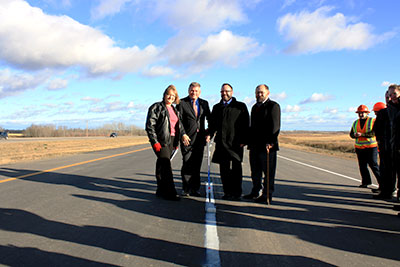
Features
Projects
Roads & Paving
Twinning Highway 11
Saskatchewan’s Highway 11 gets a needed upgrade
July 31, 2014 By Margaret Anne Fehr
Rome, as we’ve all heard, wasn’t built in a day, and the same principle holds true for road building.
Rome, as we’ve all heard, wasn’t built in a day, and the same principle holds true for road building. When the twinning of Highway 11 from Saskatoon to Prince Albert was completed, there was much to celebrate and many to thank. That was the situation on Oct. 25, 2013, when the final leg of this major project became reality. Prince Albert MP Randy Hoback and Prince Albert Carlton MLA Darryl Hickie, on behalf of Highways and Infrastructure Minister Don McMorris and other dignitaries, assembled on the highway’s mid-stripe to officially mark the occasion – one that ushers in the new future capacity for the last remaining 75-kilometre section of Highway 11.
 |
|
| Commemorating the opening of the newly twinned Highway 11. From left to right: Hon. Victoria Jurgens, MLA Prince Albert Northcote; Hon. Randy Hoback, MP Prince Albert; Hon. Daryl Hickie, MLA, Prince Albert Carlton, Hon. Delbert Kirsch, MLA, Batoche – Photo Courtesy of the Government of Saskatchewan. |
Back in 2009, both the federal and provincial governments recognized the importance of twinning the last phase of the highway, contributing equally to the $124-million project cost. Highway 11 represents Saskatchewan’s principal north-south corridor linking the three largest Saskatchewan cities of Regina, Saskatoon and Prince Albert to the TransCanada highway. The route carries as many as 20,000 vehicles per day on a stretch just south of the Corman Park Industrial access north of Saskatoon. The average overall traffic count for Highway 11 between its junction with Highway 2 south of Prince Albert and Saskatoon has increased an estimated 33 per cent over the past five years.
"Highway 11 is a vital link between Prince Albert, Saskatoon and Regina, which serves our province's resource-rich north, and supports significant mineral and timber resource development, manufacturing and tourism,” Hickie said. “The second set of lanes will provide for increased capacity, reduced logistics costs and improved access for local industries, while at the same time making for a much safer and more efficient drive for shippers, tourists and other motorists who use this busy highway."
While public attention and celebration is properly part of the proceedings in opening the highway to motorists, the complexity of the project leading up to its completion cannot be understated.
Tracy Danielson, director of design and construction, and Scott Tivy, senior project manager for the Government of Saskatchewan, were intensely involved in the design and construction phases.
 |
|
| A cross section of Saskatchewan Heavy Construction Association (SHCA) member companies representing construction, earth moving, crushing and servicing were involved in the project. |
Both engineers share the opinion that working on the highway twinning, which is such a significant project to Saskatchewan’s economic growth and safety, represents a pinnacle moment in their individual careers.
“It represents a significant improvement to safety for people traveling along that stretch of highway. It was significant for me because there was an amazing amount of work and effort that was put into the planning, design and construction, and of course, it represents a huge capital investment for Saskatchewan,” says Danielson.
While the terrain between Saskatoon and Prince Albert may appear unimpeded and uneventful to the layperson’s eye, it’s what lays beneath that is the concern to engineers and construction crews.
“From an engineering point, it may look flat on top,” says Tivy, “but the soil conditions varied considerably.” The engineer describes a terrain of farmland from Saskatoon to Duck Lake, the predominance of trees and sand in the Nesbitt Forest north of Duck Lake, and the occurrence of huge boulders, some as large as cars. “It was a unique project, and even though it looks the same on top, underneath it’s a whole different story.”
The construction methods and materials changed significantly throughout the course of the construction. Danielson describes a specific road section where the “dirt was so wet that we couldn’t build the highway on it. So we cut the ditches and we had to bring in other materials from further away to build the rest of the highway embankment.”
“On the same note,” says Tivy, “it’s been fairly wet the last couple of years and that was a big obstacle with the climate being unforgiving sometimes. We still delivered the project in the time we committed, but it did take us a bit longer because of some of the challenges we encountered.”
A cross section of Saskatchewan Heavy Construction Association (SHCA) member companies representing construction, earth moving, crushing and servicing were involved in the project.
 |
|
| “It represents a significant improvement to safety for people traveling along that stretch of highway.” – Tracy Danielson, director of design and construction.
|
With the project now completed, Danielson reflects on the residual effect that has come from years of intense collaboration and problem solving. “It has resulted in a stronger working relationship because of the duration of the project and its location. There was a lot of collaboration between the Ministry and the contractors to make the project successful. In some cases, the contractors were working very close with each other.”
For Tivy, the strength of a team approach is paramount. “You don’t build a road with one person or with just one construction company. It takes a lot of collaborative effort in order to get a product at the end of the day where you can all stand back and be proud of.”
Danielson emphasizes the level of planning that’s done beforehand. “Prior to construction, we can easily spend as much time as the construction takes, if not sometimes double that, to plan the project. But no matter how much planning we do, we will encounter some sort of challenge and we have to work together to come up with solutions that work and that are also cost-effective.”
This article was originally published in the Quarter 1, 2014, issue of Think Big, the official magazine and voice of the Saskatchewan Heavy Construction Association.
Print this page